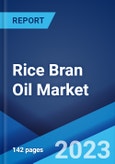Rice bran oil is an edible vegetable oil which is extracted from the outer brown layer of rice. Characterized by a mild flavor and neutral taste, it is rich in vitamin E, antioxidants, and natural bioactive phytoceuticals such as oryzanol, tocopherols, tocotrienols, and lecithin. It is exceptionally versatile and light in texture, offers delicate flavors, is suitable for high-temperature cooking, and can easily be blended with other less stable oils. Consequently, it is widely employed in various cooking methods including stir and deep-frying, sautéing, and grilling. It is also associated with reducing the risk of cancer, lowering cholesterol levels, increasing immunity, and improving the nervous system.
Rice Bran Oil Industry Drivers:
Rising awareness about the multiple health benefits offered by rice bran oil has escalated its consumption. This, in confluence with the high demand for food and beverages with low fat and high nutritional content, is strengthening the growth of the market. Moreover, the World Health Organization (WHO) and the American Heart Association have approved the use of rice bran oil, stating that its composition of monounsaturated, polyunsaturated, and saturated fats is much safer as compared to the composition of most other vegetable oils. Since this oil contains oryzanol which stimulates hair growth, protects the skin against UV rays, and prevents aging, it has emerged as an essential component in the cosmetics and pharmaceutical industries for manufacturing soaps, moisturizers, lotions, and hair care products. Other key factors that are contributing to the growth of the market include rapid urbanization, inflating disposable incomes, changing lifestyles, aggressive promotions by manufacturers, and increasing penetration in both developed and emerging markets.Key Market Segmentation:
The report provides an analysis of the key trends in each segment of the global rice bran oil market report, along with forecasts at the global and country levels from 2024-2032. Our report has categorized the market based on end-use.Breakup by End-Use:
EdibleIndustrial
Owing to the rising awareness about the health benefits of rice bran oil, it is widely used for culinary purposes on the global level.
Regional Insights:
IndiaChina
Japan
Others
On the geographical front, India is the largest producer of rice bran oil, accounting for the majority of the total global production. This can be accredited to the easy availability of raw material across the country.
Competitive Landscape:
The competitive landscape of the market has also been analyzed in the report with the detailed profiles of key players operating in the market.Key Questions Answered in This Report
1. What was the size of the global rice bran oil market in 2023?2. What is the expected growth rate of the global rice bran oil market during 2024-2032?
3. What are the key factors driving the global rice bran oil market?
4. What has been the impact of COVID-19 on the global rice bran oil market?
5. What is the breakup of the global rice bran oil market based on the end-use?
6. What are the key regions in the global rice bran oil market?
7. Who are the key players/companies in the global rice bran oil market?
Table of Contents
Methodology

LOADING...
Table Information
| Report Attribute | Details |
|---|---|
| No. of Pages | 140 |
| Published | July 2024 |
| Forecast Period | 2023 - 2032 |
| Estimated Market Value in 2023 | 1.8 Million Tons |
| Forecasted Market Value by 2032 | 2.1 Million Tons |
| Compound Annual Growth Rate | 1.7% |
| Regions Covered | Global |









